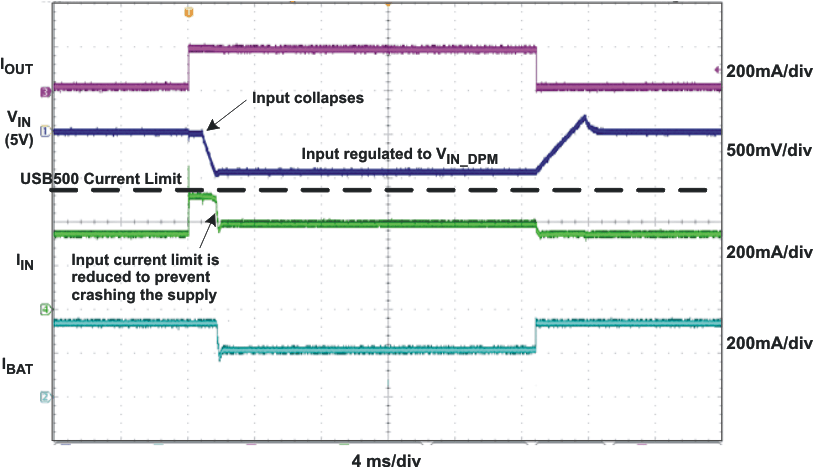SLUSCM2B October 2017 – November 2018
PRODUCTION DATA.
- 1 Features
- 2 Applications
- 3 Description
- 4 Revision History
- 5 Description (continued)
- 6 Device Comparison Table
- 7 Pin Configuration and Functions
- 8 Specifications
-
9 Detailed Description
- 9.1 Overview
- 9.2 Functional Block Diagram
- 9.3 Feature Description
- 9.4 Device Functional Modes
-
10Application and Implementation
- 10.1 Application Information
- 10.2 Typical Application – bq24079QW-Q1 Charger Design Example
- 11Power Supply Recommendations
- 12Layout
- 13Device and Documentation Support
- 14Mechanical, Packaging, and Orderable Information
Package Options
Refer to the PDF data sheet for device specific package drawings
Mechanical Data (Package|Pins)
- RGT|16
Thermal pad, mechanical data (Package|Pins)
- RGT|16
Orderable Information
9.3.4.1.1 Input DPM Mode (VIN-DPM)
The bq24079QW-Q1 uses the VIN-DPM mode for operation from current-limited USB ports. When EN1 and EN2 are configured for USB100 (EN2 = 0, EN1 = 0) or USB500 (EN2 = 0, EN2 = 1) modes, the input voltage is monitored. If VIN falls to VIN-DPM, the input current limit is reduced to prevent the input voltage from falling further. This prevents the bq24079QW-Q1 from crashing poorly designed or incorrectly configured USB sources. Figure 21 shows the VIN-DPM behavior to a current limited source. In this figure, the input source has a 400-mA current limit and the device is in USB500 mode (EN1 = 1, EN2 = 0).
 Figure 21. VIN-DPM Waveform
Figure 21. VIN-DPM Waveform